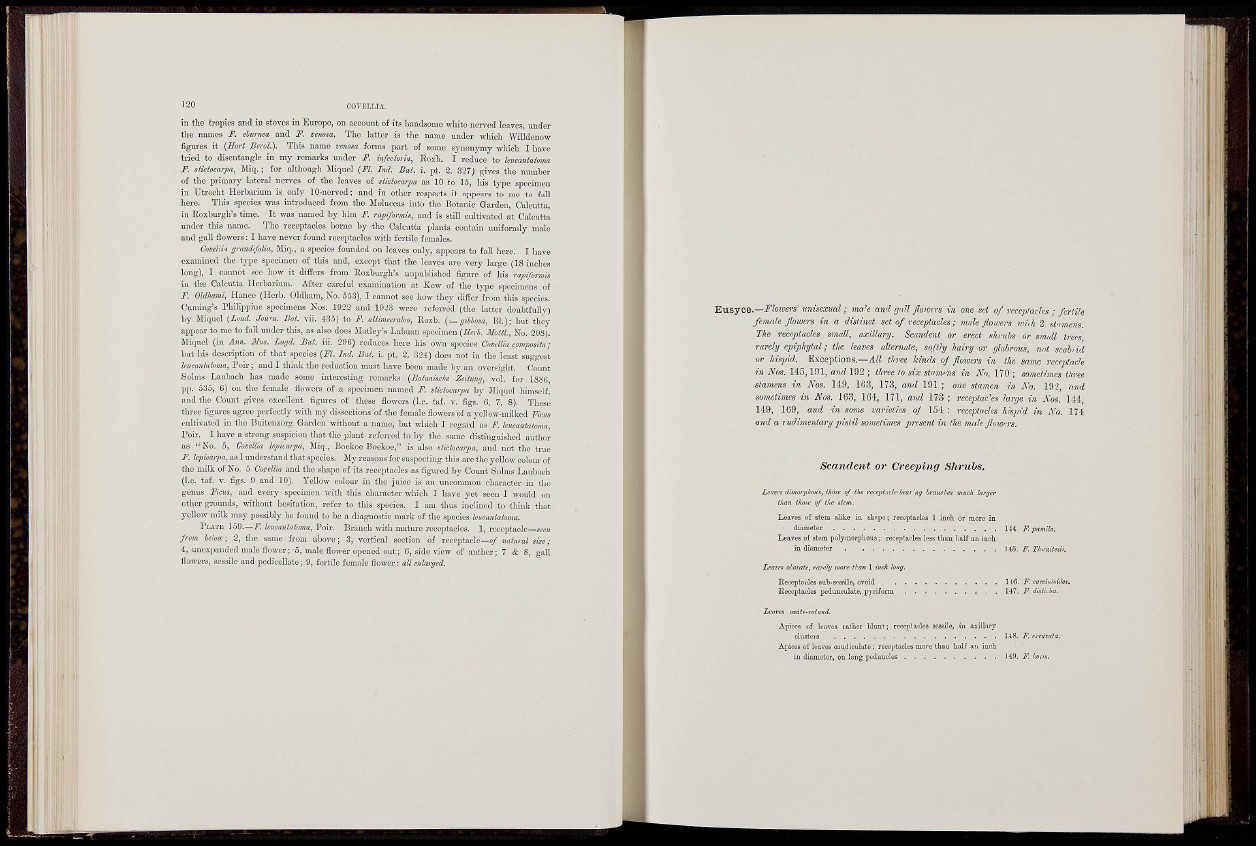
in the tropics and in stoves in Europe, on account of its handsome wliite-nerved leaves, under
the names F. ehurnea and F. vcnosa. The latter is the name \mder "whicli Willdeno-w
figures it {Ilort Berol). Tliis name vcnosa foi-ms part of some synonymy which I have
tried to disentangle in my remarks under F. mfeetoria, Rosb. I reduce to leiicantatoma
F. stictoearpa, Miq.; for although Miguel {PL Lid. Bat. i, pt. 2. 327j gives the number
o£ the primary lateral nerves of the leaves of stklocio-pa as 10 to 15, his tj'pe specimen
in Utrecht Herbarium is only lO-nervcd; and in other respects it ajjpears to nie to fall
liere. This species was inti-oduced from tlic Moluccas into the Botanic Garden, Calciitta,
in Roxbm-gh's time. It was named by him F. rapiformis, and is still cultivated at Calcutta
under this name. The receptacles borne by tho Calcutta plants contain unifonniy male
and gall flowers: I have never found receptacles with fertile females.
CoveVm grandifolia, Miq., a species founded on leaves onl)', appears to fall hei-e. I have
examined tho tjiDe specimen of this and, except that the leaves ai-e very lai-ge (18 inches
long), I cannot see how it differs from Roxburgh's unpublished figm-e of his rapiformis
in the Calcutta Herbarium. After careful examination at Kew of the type specimens of
F. Oldhami, Ilancc (Hei-b. Oldham, No. 553), I cannot see how they differ from this species.
Cuming's Philippine specimens Nos. 1922 and 19^3 were referred (the latter doubtfully)
by Miq^ucl [Land. Jou^n. Bot vii. 435) to F. altimeeraloo, Eoxb. gibbosa, Bl.); but they
appear to me to fall under this, as also does Motley's Labuan specimen {Ilorb. Mottl, No. 208).
5[iqucl (in Ann. Mus. Lugd. Bat. iii. 296) reduces here his own species Covellia composita;
but liis description of that species {Fl. Ind. Bat. i. pt. 2. 324) does not in the least suggest
leucanialoma, Poir; and I think the reduction must have been made by an oversight. Count
Solms Laubach has made some interesting remarks {Botanische Zeitung, vol. for 1886,
pp. 535, 6) on the female flowers of a specimen named F. stictocarpa by Miquel himself,
and the Count gives excellent figm-es of these flowers (I.e. taf. v, figs. 6, 7, 8). These
tln-ee figures agree perfectly with my dissections of the female flowers of a yellow-mflked Ficus
cultivated in the Buitenzorg Garden without a name, but winch I regard as F. leucantatoma,
Poir. I have a sti-ong suspicion that the plant re£en-ed to by the same distinguished author
as "No. 5, Covellia lepicarpu, Miq., Boekoe Boekoe," is also stictocarpa, and not the true
F. Icpicarpa, as I understand that species. My reasons for suspecting this are tho yellow colour of
the milk of No. 5 Covellia and the shape of its receptacles as figm-ed by Count Solms Laubach
(l,c. taf. V. figs. 9 and 10). Yellow colour in the juice is an uncommon character in the
genus Ficus, and every specimen with this character which I have yet seen I would on
other grounds, without hesitation, refer to this species. I am thus inclined to think that
yellow milk may possibly be found to be a diagnostic mark of the species leuoaiiiatoma.
Plate 159.—F. leucantatoma, Poir, Branch with matm-e receptacles. 1, receptacle—seciz
from heloiD] 2, the same from above; 3, vertical section of receptacle—o/ natural size;
4, unexpanded male flower; 5, male flower opened out; 6, side view of anther; 7 & 8, gall
flowers, sessile and pedicellate; 9, fertile female flower: all enlarged.
'Ensyce—Flowers unisexual; male and gaU flowers in one set of vecepiades ; fertile
female flowers in a distinct set of receptacles; male fioioers touh 2 stamens.
The receptacles small, axillary. Scandent or erect shrjibs or smull trees
rarely epiphytal; the leaves alternate, softly hairy or glabrous, not scahrid
or hispid. Exceptions.—All three kinds oj floioers in the same receptacle
in Nos. 145,191, and 192 ; three to six stum-ns in No. 170 ; sometimes three
stamens in Nos. 149, 163, 173, and 191 ; one stamen in No. 19'2, nnd
sometimes in Nos. 163, 1G4, 171, and 173 ; receptacles large in Nos. 144
149, 169, and in some varieties of 154 : receptacles hispid in No. 174
ond a ludimeniary pistil sometimes p)rcsent in the male flowf.rs.
Scandent or Creeping Shrubs.
Leaves dimorphous, thc^e of the rcccptaclc-bear'ng hranchea much larger
than those of the ¡stem.
Leayea of stem alike in sknpe; reoeptaeles 1 inck or moro in
diameter H4 F. pumlla.
Leaves of stem polyuiorplious; receptacles less than lialf au incli
ia diameter 145. F. T/m-ailesii.
Leaves obovafe, rarely more than 1 inch Jong.
Eeoeptades sub-spssile, ovoid M6. F. caecini'dJes.
Eeceptaoles pedunculate, p j r i fom 147. F diUicha.
Leaves ovate-rohmd.
Apices of leaves latlicr blunt; receptacles sessile, ia axillary
clusters Ii8. F. e^-eavata.
Apices of loavos caudioiibte; receptacles more thau half an infill
in diameter, on long peduncles H9. F. hiis.